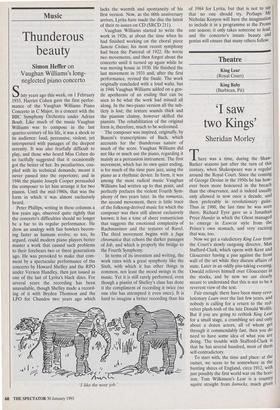Mu sic
Thunderous beauty
Simon Heifer on Vaughan Williams's long- neglected piano concerto Sixty years ago this week, on 1 February 1933, Harriet Cohen gave the first perfor- mance of the Vaughan Williams Piano Concerto in C Major, in a concert with the BBC Symphony Orchestra under Adrian Boult. Like much of the music Vaughan Williams was to compose in the last quarter-century of his life, it was a shock to its audience: loud, percussive, violent, yet interspersed with passages of the deepest serenity. It was also fearfully difficult to play, and those who heard Miss Cohen do so tactfully suggested that it occasionally got the better of her. Its peculiarities, cou- pled with its technical demands, meant it never passed into the repertoire; and in 1946 the pianist Joseph Cooper persuaded the composer to let him arrange it for two pianos. Until the mid-1980s, that was the form in which it was almost exclusively heard.
Peter Phillips, writing in these columns a few years ago, observed quite rightly that the concerto's difficulties should no longer be a bar to its regular performance. He drew an analogy with fast bowlers becom- ing faster as humans evolve; so too, he argued, could modern piano players better master a work that caused such problems to their forebears two or three generations ago. He was provoked to make that com- ment by a spectacular performance of the concerto by Howard Shelley and the RPO under Vernon Handley, then just issued as one of the last of Lyrita's black discs. For several years the recording has been unavailable, though Shelley made a record- ing of it with Bryden Thomson and the LPO for Chandos two years ago which lacks the warmth and spontaneity of his first version. Now, as the 60th anniversary arrives, Lyrita have made the disc the latest of their re-issues on CD (SRCD 211).
Vaughan Williams started to write the work in 1926, at about the time when he had finished working on the choral piece Sancta Civitas; his most recent symphony had been the Pastoral of 1922. He wrote two movements, and then forgot about the concerto until it turned up again while he was moving house in 1930. He finished the last movement in 1931 and, after the first performance, revised the finale. The work originally concluded with a loud waltz, but in 1946 Vaughan Williams added on a gen- tle apotheosis of an ending that can be seen to be what the work had missed all along. In the two-piano version all the sub- tlety is lost; the texture sounds thick and the pianism clumsy, however skilled the pianists. The rehabilitation of the original form is, therefore, much to be welcomed.
The composer was inspired, originally, by Busoni's transcriptions of Bach, which accounts for the thunderous nature of much of the score. Vaughan Williams did not like or much use the piano, regarding it mainly as a percussion instrument. The first movement, which has its own quiet ending, is for much of the time pure jazz, using the piano as a rhythmic device. In form, it was among the most radical music Vaughan Williams had written up to that point, and perfectly prefaces the violent Fourth Sym- phony of two years later. In the romanza, the second movement, there is little trace of the folksong-derived music for which the composer was then still almost exclusively known; it has a tone of sheer romanticism that suggests the emotional complexity, of Rachmaninov and the textures of Ravel. The third movement begins with a fuga chromatica that echoes the darker passages of Job, and which is properly the bridge to the Fourth Symphony.
In terms of its invention and writing, the work rates with a great symphony like the Sixth, with which it has other things in common, not least the mood swings in the music. Yet it is still rarely performed, even though a pianist of Shelley's class has done it the compliment of recording it twice (no one else has attempted it even once). It is hard to imagine a better recording than his like the nose job.' of 1984 for Lyrita, but that is not to saY that no one should try. Perhaps Mr Nicholas Kenyon will have the imagination to include it in a programme at the Proms one season; it only takes someone to lead, and the concerto's innate beauty and genius will ensure that many others follow.










































































 Previous page
Previous page